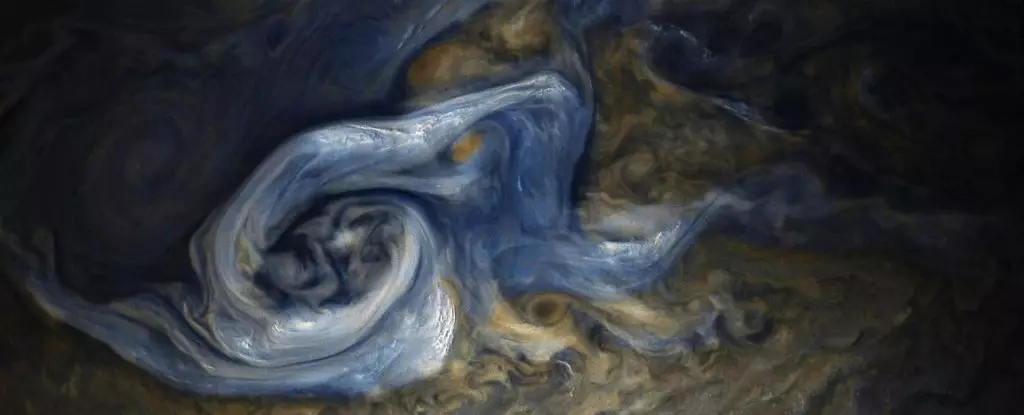When it comes to planetary atmospheres, Jupiter garners a hefty share of fascination from scientists and enthusiasts alike. Despite bearing some striking resemblances to Earth’s weather phenomena, Jupiter’s atmosphere presents enigmas that defy conventional expectations. Recent research has ignited excitement in the scientific community by uncovering an astonishing weather event: the formation of “mushballs” during Jupiter’s ferocious storms. Unlike anything seen on our planet, these peculiar meteorological occurrences provide insights into the dynamics of gas giants and their atmospheric compositions, especially concerning ammonia, a crucial compound for understanding planetary atmospheres.
The Mushball Revelation
Imagine a storm producing hail that resembles a cross between wet snow and your favorite slushee. This whimsical analogy reflects how the mushballs are formed—clusters of ice made of ammonia and water that emerge from Jupiter’s tumultuous storms. As planetary scientist Chris Moeckel from UC Berkeley reflected on this phenomenon: “It seemed so exotic. I basically spent three years trying to prove this wrong, and I couldn’t.” The very fact that these mushballs exist is a testament to the intricate and chaotic nature of Jupiter’s atmosphere.
This hypothesis first took root in 2020 when data from the Juno probe suggested an unexpected mechanism for extracting ammonia and water from Jupiter’s upper atmosphere. The proposal was revolutionary: massive storms eject water high into the atmosphere, which then encounters ammonia vapor, resulting in exotic ice formations. This unique chemical interplay challenges our conventional understanding of cloud formation and challenges Earth’s meteorological frameworks.
Exploring the Atmospheric Deep
Digging deeper into Jupiter’s atmosphere reveals a complex three-dimensional structure that defies surface-level observations. Previous assumptions suggested that most of Jupiter’s weather phenomena were shallow, sitting just beneath the visible cloud tops. Yet, studies conducted by Moeckel and his colleagues unveiled weather systems plunging as deep as 150 kilometers into the atmosphere. This insight is crucial since it emphasizes that merely observing the ‘surface’ is deceptive; what lies beneath is vastly different and more complex.
This depth-related understanding is pivotal for interpreting atmospheric behavior across the solar system’s gas giants. Storms like the ones on Jupiter don’t just exist in isolation; they are manifestations of larger processes that transport various compounds throughout a planet’s interior. This radical understanding of vertical weather systems paves the way for more accurate models of atmospheric dynamics.
The Mechanism of Mushball Formation
The formation of mushballs involves an intriguing process of updrafts and rapid mixing that must occur simultaneously to create these curious aggregates. Water is transported upward in these intense updrafts and encounters ammonia, which serves as a melting agent. These two substances mix at ratios of approximately three parts water to one part ammonia, leading to the creation of mushballs, which then precipitate down into the depths of Jupiter’s atmosphere.
Moeckel and his team dissected data from the Juno probe and the Hubble Space Telescope, focusing on signals that hinted at an amalgamation of melting ice or ammonia enhancement below the clouds—potentially confirming the mushball theory. This groundbreaking evidence hints at a systematic process that influences atmospheric ammonia levels, a factor that has baffled scientists for years.
Beyond Jupiter: Implications for the Solar System
One of the most genuinely exciting implications of this research is the potential for similar atmospheric processes existing on other gas giants like Saturn, Uranus, and Neptune. If mushball storms are indeed a byproduct of the mechanics behind gas giant weather systems, it would revolutionize our understanding of atmospheric science across the solar system.
By investigating water and ammonia interactions in various celestial environments, we can foster a deeper comprehension of not just individual planets, but also the fundamental workings of atmospheres beyond our Earth. This investigation transcends planetary boundaries, opening new avenues for research that could lead to revolutionary discoveries about the atmospheric dynamics of exoplanets.
The Continuing Journey of Discovery
The scientific journey to understand Jupiter’s unique weather phenomena underscores how much remains unknown in our universe. As research continues and new technologies allow us to probe deeper into planetary atmospheres, we eagerly await the revelations regarding not just Jupiter, but the myriad of worlds that share our solar neighborhood. The implications extend beyond curiosity; they touch the very fabric of planetary science and our desire to comprehend the complexities of life-sustaining processes throughout the cosmos.
Understanding Jupiter is not merely an exercise in astronomy; it shapes our perceptions of planetary formation, chemical interactions, and, ultimately, the conditions necessary for life. As we unlock these brutal mysteries of our solar system’s largest planet, we cultivate an ever-increasing appreciation for the tumultuous beauty of our cosmic neighborhood.


Leave a Reply